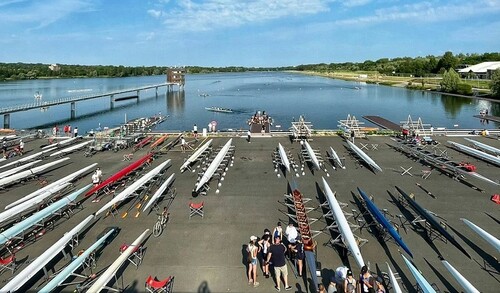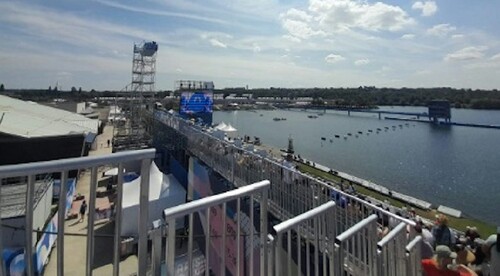How to republish
Read the original article and consult terms of republication.
What does the future hold for the Vaires-Torcy Leisure Island, the 2024 Olympics site?
By Antoine Marsac, Associate Professor in the Sociology of Sport, Université Gustave Eiffel.

Vaires-Torcy Leisure Island in the Île-de-France region existed prior to the Olympic Games, but the event was an opportunity to give the whole place a makeover. What sort of legacy will Paris 2024 leave behind? And how have these changes to the area impacted the people who come to the leisure island regularly?
Last summer, the Vaires-Torcy Leisure Island hosted the rowing and canoeing/kayaking events for the Paris 2024 Olympic and Paralympic Games. It is one of only three places in the world to be able to host all Olympic rowing and paddling events. From the moment it was chosen as an Olympic site, some significant structural transformations were required, to make sure the site was compliant with Olympic specifications (sports facilities, access routes, etc.). The leisure island was up to the challenge to play host to this huge event, while ensuring some leisure facilities remained accessible for the locals. But the balance was fragile due to the twofold nature of the developments to accommodate both high-performance sport and recreational areas, raising questions about these developments planned for the leisure island of Vaires-Torcy. What developments will be required before and during the Olympic Games? What sort of legacy will Paris 2024 leave behind? How will these changes affect the users of this leisure island?
A survey carried out using photographs, observations and semi-structured interviews will shed light on how the site is managed, the different practices and the developments for this leisure island belonging to the Île-de-France (IDF) region. It will also illustrate the repercussions of these Olympic facilities for walkers.
One side for sports and one side for leisure
With a surface area of 350 hectares, it is one of the biggest leisure complexes in the Paris region. This site is in the Paris Vallée de la Marne urban area, 32.8 km from Paris Notre-Dame and stretches across the towns of Vaires-sur-Marne, Torcy and Chelles. It is also only a few kilometres from the French National Institute of Sport, Expertise, and Performance. This natural area was designed to be able to welcome athletes as well as locals looking for a cool and refreshing place. There are two distinct spaces at the leisure island: a sports side (Vaires-sur-Marne) with a dedicated pool in calm waters, and white water stadiums, and a leisure side (Torcy) with areas for swimming, horse riding and footpaths.

This is a place where local residents can escape city life in IDF, and can be described as a "compensatory elsewhere". There are both relaxation areas and sports facilities available, so visitors can do water sports or just go for a stroll close to home. It is defined a sort of complex "with everything you need to enjoy activities in the great outdoors, cultural studies, to relax and recharge your batteries in a natural environment close to its users".
This leisure island opened in 1990 and since the beginning it has hosted various rowing and canoeing/kayaking competitions. After being chosen as an Olympic site, this complex in Vaires-sur-Marne was given a makeover for the 2024 Olympic and Paralympic Games. It was the first French site to be handed over to the Paris 2024 Organising Committee in 2019, and became the hub for rowing and paddling sports. During the Olympic and Paralympic Games, 36,000 visitors came here per day, making it the second biggest in terms of capacity after the Stade de France.
Used by both the general public and high-level athletes
With 612 000 visitors per year, the leisure island is one of the most popular places in the Île-de-France region. It boasts some very specific features due to the fact it can welcome high-performance athletes. It is managed under a public service delegation contrac – in the future, the owner (Île-de-France region) would like to entrust the management of leisure islands to agents – with a dual purpose: high-performance sport and recreational activities for the general public. This place owes its popularity to the two white water stadiums offering optimal conditions for athletes to train.
The sports and other facilities at the leisure island had to be redeveloped to accommodate the Olympic and Paralympic Games, at a cost of 101 million euros. The two-kilometre-long pool, marked out by the water lines, is the highlight of the leisure island, with a finish tower, a start pontoon, five embarkation and disembarkation pontoons (accessible to people with reduced mobility (PRM)) and a paved road so coaches can monitor their athletes from dry land. Temporary installations such as tiered seating, TV towers and a row of anti-wave buoys were installed.
The whole leisure island (excluding the area reserved for athletes) is open to visitors 24 hours a day, with footpaths suitable for all sorts of active mobility and accessible for people with reduced mobility.

Credit: Antoine Lefebvre (provided by the author)
The impact of the Games
But the redevelopments at the site meant that it was partially closed to the public. These transformations have been disruptive to biodiversity, as well as the habits of visitors and visitor numbers. While the construction of the water sports stadium has transformed around a quarter of the complex, the issue of protecting the environment is no less pressing. The consequences are the disappearance of ponds and reed beds, and changes to the flora and fauna.
More than 62% of users live less than 10 kilometres from the site the closure and modifications to the areas under development therefore had a significant impact on users. These are mainly families, young people, the retired, sports enthusiasts or people with reduced mobility. For some, the leisure island is somewhere they can recharge their batteries and exercise:
"It’s sunny, the sky is blue, the water is glistening, and you see, this is like a mini holiday for me! […] For everyone living in apartments […] we need gardens, nature."
In the run-up to the Olympics, the redevelopment works were a real issue for walkers:
"I come here because I like exercising here. That’s my way of relaxing. […]. It’s peaceful. It’s relaxing […] but at the moment that’s not possible."
Or:
"All the fencing and barriers make us feel like we’re in a pig pen"
After the Olympic and Paralympic Games, these people resumed their usual walks. During our visits, we noticed that users were using paths alongside those of the leisure island. Setting up the area in a "show" configuration had a direct impact on users, who were restricted to certain areas from the 17 June. The closure of this area during the summer was problematic for families who didn’t go on holiday. In fact, it caused a lot of people to switch to other nearby leisure complexes, which in turn, created issues in terms of surveillance and safety at these sites.
The survey highlighted the consequences of the redevelopment of the Vaires-sur-Marne Olympic site for its users. The Olympic Games were a great success with both spectators and athletes, who were provided with the optimal conditions to perform, but they have also had an impact on the walking areas and local ecosystem.
The years following the Olympic Games will be crucial for the future of the Vaires-Torcy Leisure Island, and all will depend on the choices made by the managing bodies. Who will be permitted to access and use the facilities there, and under what conditions? Will the walking areas be restored?

Credit: Antoine Marsac (provided by the author)
This work was carried out as part of the research workshop NUMCAP 3 of the Labex Urban Futures Graduate School Programme of the Université Gustave Eiffel.
Lucile Barbaudy, Antoine Lefebvre and Aristide Vidagbandji, students on a Master’s 2 STAPS, Sport and Social Sciences programme, helped write this article.
Identity card of the article
Original title: | Comment va évoluer l'île de loisirs de Vaires-Torcy, site des JO 2024 ? |
Author: | Antoine Marsac (Université Gustave Eiffel) |
Publisher: | The Conversation France |
Collection: | The Conversation France |
Licence: | This article is republished from The Conversation France under Creative Commons licence. Read the original article. An English version was created by Hancock & Hutton for Université Gustave Eiffel and was published by Reflexscience under the same license. |
Date: | February 19, 2025 |
Languages: | French and English |
Key words: | Sport, urban development, leisure, land-use planning, 2024 Olympic Games |

![[Translate to English:] Licence creative commons BY-SA 4.0 [Translate to English:] Licence creative commons BY-SA 4.0](https://reflexscience.univ-gustave-eiffel.fr/fileadmin/ReflexScience/Accueil/Logos/CCbySA.png)